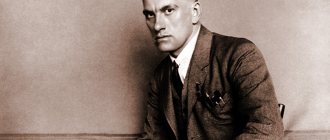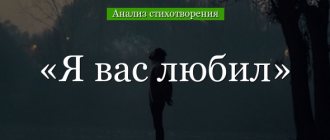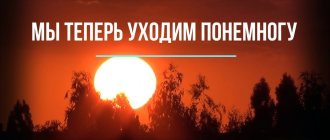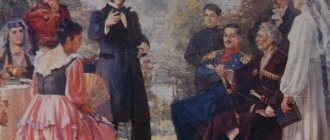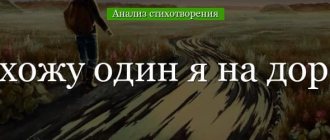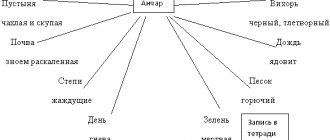4.1
Average rating: 4.1
Total ratings received: 178.
4.1
Average rating: 4.1
Total ratings received: 178.
Mayakovsky’s poem “Good attitude towards horses” is a typical example of the poet’s early lyrics. In his youth, he was concerned with the theme of confrontation between man and the crowd, to which he dedicated many of his works. A brief analysis of “A Good Treatment for Horses” is planned to examine just such a poem; it can be used as the basis for a literature lesson in the 5th grade.
The material was prepared jointly with a teacher of the highest category, Kuchmina Nadezhda Vladimirovna.
Experience as a teacher of Russian language and literature - 27 years.
Brief Analysis
Before reading this analysis, we recommend that you familiarize yourself with the poem A Good Attitude Toward Horses.
History of creation - the work was written in 1918, when other poets, also caught in the whirlwind of the revolution, wrote mainly about it.
The theme of the poem is love for the most common working animal, which symbolizes ordinary people.
The composition is a consistently developing story from the moment the horse falls until it gets up and continues its path.
Genre : lyric poem.
The meter of the verse is tonic – accented verse.
Epithets – “horse eyes”, “general animal melancholy”, red-haired child.”
Metaphors - “the street overturned”, “laughter rang out”, “melancholy poured out”.
Neologisms – “flare”, “neigh”.
Theme of the poem, summary
Unlucky at first glance, the work touches on painful issues of the society of that time and numerous problems . First of all, the writer talks about his love for the dray nag, which personifies simple hardworking people working for the good of the country. But society is not able to thank those who work for the good of their homeland; it exalts itself higher.
In addition, by analyzing Mayakovsky’s poem “A Good Treatment for Horses,” one can identify such important themes as indifference and cruelty that worried young Vladimir at that time. The lyrical hero unwittingly finds himself drawn into a situation when an old nag, tired of tedious work, collapses. People simply walk past the emaciated animal, point their fingers, and laugh. Nobody offers the horse help.
The author is trying to convey to the readers the main idea - you need to be kinder. The lyrical hero sympathizes with the hardworking animal, he speaks encouraging words to him. They encourage the horse, which gets back on its feet and continues on its way. At this moment, the horse feels like a little child, cheers up, because he understands that all efforts are not in vain, someone appreciates them.
The writer is trying to say that we need to encourage each other so that the burden of life does not seem so heavy.
History of creation
Mayakovsky wrote to Lilya Brik about the concept of this work. The poet acutely felt that in the midst of the revolution people became embittered, they were overcome by fear, they did not show mercy or even simple attention to each other. It was during this period, as the history of the creation of “A Good Relationship with Horses” says, that he came up with the idea of “something heartfelt about a horse.” The poem was obviously written after May: then Lilya Brik received a letter from the poet in which he outlined his idea.
The year 1918 was also important for Mayakovsky himself: he was already recognized in literary circles, but he felt sad that no one understood him. He transferred his emotional state into poetic form and created a kind of cry from the soul that could not get through to people. At the same time, the poet emphasizes the desire to continue to create, hoping to one day be understood and accepted by at least one person.
main idea
The monologue of the lyrical hero about the similarity of man and horse evokes a feeling of sadness. But, thanks to friendly support, the mare overcomes herself and still gets up. You shouldn’t give up, the author believes, even if the clouds are gathering and it seems that no one needs you or your work.
Although the poem has a bright revolutionary overtones, in it the author, first of all, shows humanism and reveals his kind, compassionate nature. The main idea of the poem is that you should not pass by someone who needs help. We need to at least support him in difficult times, because we are all alike, no one is immune from life’s failures and fatal accidents. The protagonist's speech touches people's hearts and helps them understand that responsiveness and sensitivity to others are necessary in life.
Author: Victoria Klipinina
Interesting? Save it on your wall!
Subject
This work touches on many issues. First of all, this is love for the dray nag, that is, ordinary working people who work for the good of society. And this society is not always as grateful to them as it should be.
The theme of indifference and cruelty, which greatly worried Mayakovsky at that time, also becomes the subject of consideration in this poem. The lyrical hero witnesses a situation when a poor old horse, tired of work, falls, and people around, instead of helping the animal or at least sympathizing with it, only laugh and point their fingers.
And here the poet expresses the main idea: we must be kinder. The simple sympathetic words of the lyrical hero were enough for the old nag to not just get up and walk. No, she became happier, felt like a child and realized that all her efforts were not in vain. Everyone and everyone needs to do the same: people should be kind to each other so that the burden of life is not so heavy for them.
Text
The hooves were beating. They sang as if: “Mushroom.” Rob. Coffin. Rough —
Blown by the wind, shod with ice, the street slid. The horse fell on its croup, and immediately behind the onlooker the onlookers, who had come to flare Kuznetsky’s pants, huddled together, laughter rang and tinkled: “The horse fell!” - - The horse fell! - Kuznetsky laughed. Only I did not interfere with my voice in his howl. I came up and saw the eyes of a horse...
The street has turned over, flowing in its own way... I approached and saw - behind the drops of drops, the drops were rolling down the face, hiding in the fur...
And some kind of general animal melancholy of the splash poured out of me and blurred into a rustle. “Horse, don’t. Horse, listen - why do you think that you are worse than them? Baby, we are all a little bit of a horse, each of us is a horse in our own way.” Maybe the old one didn’t need a nanny, maybe my thought seemed to suit her, only the horse rushed, stood up, neighed and walked away. She wagged her tail. Red-haired child. The cheerful one came and stood in the stall. And everything seemed to her - she was a foal, and it was worth living, and it was worth working.
1918
Composition
This is a story in poetic form, almost a report, the plot of which develops sequentially: the horse falls - they make fun of it - the lyrical hero comes and encourages it - she is happy, so she finds the strength to get up.
Using these images, Mayakovsky also tells his own story: in 1918, the poet worked hard, trying to benefit the new, emerging Soviet society, but continued to feel like an outcast. Like the horse, at some point he decided to stop trying, but still continued to work for people - this is the meaning of the verse.
Analysis of the poem “Good attitude towards horses”
And everything seemed to her -
and it was worth the work.
V. Mayakovsky’s poem “Good attitude towards horses” goes back to the pages of Russian classics and folklore. In Nekrasov, Dostoevsky, Saltykov-Shchedrin, the horse often symbolizes an uncomplaining, submissive worker, helpless and oppressed, evoking pity and compassion.
It’s curious what creative problem Mayakovsky solves in this case, what does the image of an unhappy horse mean to him? Mayakovsky, an artist whose social and aesthetic views were very revolutionary, proclaimed with all his work the idea of a new life, new relationships between people. The poem “A Good Treatment for Horses,” with its novelty of artistic content and form, affirms the same idea.
Compositionally, the poem consists of 3 parts, symmetrically arranged: the first (“the horse fell”) and the third (“the horse… went”) frame the central one (“the horse’s eyes”). The parts are connected by both the plot (what happens to the horse) and the lyrical “I”. First, the attitude of the lyrical hero and the crowd to what is happening is contrasted:
He didn’t interfere with his voice when he howled.
Then the horse’s eyes are shown in close-up and there are tears in them “behind the drops of the chapel” - a moment of humanization that prepares the climax of the lyrical hero’s experience:
We are all a little bit of a horse
Each of us is a horse in our own way.
The plot denouement and its assessment by the author (“merry came... and it was worth living and worth working”) reflects the semantic result of the poem.
The figurative system within which the lyrical conflict unfolds is represented by three sides: the horse, the street, and the lyrical hero.
Mayakovsky's horse figure is very unique: it is devoid of signs of a victim of a social conflict. There is neither a rider nor luggage that could personify hardships and oppression. And the moment of the fall is not due to fatigue or violence (“I was shod with ice, the street was slipping…”). The sound side of the verse emphasizes the hostility of the street. Alliteration:
not so much onomatopoeic (Mayakovsky did not like this), but rather meaningful and, in combination with the words “croup”, “crashed”, “huddled” at the sound level, gives an “increment” of meaning. The street in early Mayakovsky is often a metaphor for the old world, philistine consciousness, and an aggressive crowd.
The crowd will go wild... (“Here!”)
The crowd piled in, huge, angry. (“That’s how I became a dog.”)
In our case, this is also an idle crowd, dressed up:
...behind the onlooker there is an onlooker,
The pants that Kuznetsky came to have bell-bottoms...
It is no coincidence that the street is Kuznetsky, which has a trail of certain associations since the time of Griboedov (“from where fashion came to us...”). The unceremoniousness of the crowd is emphasized by the choice of verbs: “the laughter rang and tinkled.” The sounds “z”, “zv”, persistently repeated, reinforce the meaning of the word “onlooker”; the same is emphasized by the rhyme: “onlooker” - “tinkled.”
Contrasting the “voice” of the lyrical hero with the “howl” of the crowd and bringing it closer to the object of everyone’s attention is carried out lexically, syntactically, phonetically, intonationally, and also with the help of rhymes. Parallelism of verbal constructions (“I came up and saw”), rhymes (“I am the only one” - “horse”, “howl to him” - “in my own way”, visual (eyes) and sound images (“behind the temples of the temple...rolls”, “splash”) - a means of enhancing the impression of the picture itself, thickening the emotions of the lyrical hero.
“General animal melancholy” is a metaphor for the complex psychological state of the lyrical hero, his mental fatigue and hopelessness. The sounds “sh - shch”, going back to the word “general”, become cross-cutting. The affectionate and condescending address “baby” is addressed to “those in need of a nanny,” that is, to those who associate their state of mind with Mayakovsky’s soft and, in their own way, deep maxim: “... we are all a little bit of a horse, each of us is a horse in our own way.” The central image of the poem is enriched with new semantic shades and acquires psychological depth.
If Roman Yakobson is right, who believed that Mayakovsky’s poetry is “the poetry of highlighted words,” then these words in the final fragment of the poem should apparently be considered “worth living.” Pun rhyme (“went” - “went”), persistent reinforcement of meaning by sound and rhyme (“rushed”, “neighed”, “red child” - “fat child”), repetition of etymologically related words (“ stood up”, “became”, “stall”), homographic proximity (“stall” - “stood”) give an optimistic, life-affirming character to the ending of the poem.
Fans of Mayakovsky hold this poem in special regard. Written in 1918, it is not distinguished by political acuteness, like “Ode to the Revolution” or “Left March” and does not give rise to pseudo-literary speculation. According to the attitude of the lyrical hero, the poem is close to the earlier one - “The violin and a little nervously.” They are brought together not by revolutionary pathos, but by longing for lost mutual understanding, the desire to find like-minded people, to “get back on their feet.” "live together".
This overcoming of alienation, the unity of like-minded people is the ideal of the author, whose poetic skill and innovation overcome vulgarity and captivate with its originality, brightness, and love of life.
How often in life does a person need support, even just a kind word. As they say, a kind word also pleases a cat. However, sometimes it is very difficult to find mutual understanding with the outside world. It was this theme - the confrontation between man and the crowd - that the early poems of the futurist poet Vladimir Mayakovsky were devoted to. In 1918, during the ordeal of the young Soviet republic, in the days when other poets such as Alexander Blok were calling:
Keep your revolutionary pace! The restless enemy never sleeps!
- it was at such a time that Mayakovsky wrote a poem with an unexpected title - “A Good Attitude towards Horses”, to which the analysis is devoted.
This work immediately amazes with its abundance of alliteration. The plot is based on the fall of an old horse, which aroused not just the lively curiosity of the crowd, but even the laughter of onlookers who surrounded the place of the fall. Therefore, alliteration helps to hear both the clatter of the old nag’s hooves (“Mushroom. Rob. Coffin. Rough.”) and the sounds of the crowd thirsting for a spectacle (“Laughter rang and tinkled,” “behind the onlooker there is an onlooker”).
It is important to note that the sounds imitating the heavy tread of a nag also carry a semantic connotation: the peculiar call “Rob” in combination with the words “coffin” and “rude” is especially clearly perceived. In exactly the same way, the tinkling laughter of onlookers, “who came to check Kuznetsky’s pants,” merges into a single howl, reminiscent of a pack of portages. This is where the lyrical hero appears, who “did not interfere with his voice alone in the howl,” a hero who sympathized with the horse, which not only fell, but “crashed,” because he saw “the horse’s eyes.”
What did the hero see in those eyes? Longing for simple human participation? In M. Gorky’s work “The Old Woman Izergil,” Larra, who rejected people, since he himself was the son of an eagle, did not live without them, and when he wanted to die, he could not, and the author wrote: “There was so much melancholy in his eyes that it was possible would poison all the people of the world with it.” Perhaps there was just as much of her in the eyes of the unfortunate horse, but those around her did not see it, although she was crying:
Behind the droplet, the droplet rolls down the face, hides in the fur...
The hero’s sympathy turned out to be so strong that he felt “some kind of general animal melancholy.” It is this universality that allows him to say: “Baby, we are all a little bit of a horse, each of us is a horse in our own way.” Indeed, hasn’t everyone had days when failures followed one after another? Didn't you want to give up everything and give up? And some even wanted to kill themselves.
How to help in such a situation? Support, say words of consolation, sympathy, which is what the hero does. Of course, uttering his words of encouragement, he realizes that “maybe the old one didn’t need a nanny,” because not everyone is pleased when there are witnesses to his momentary weakness or failure. However, the hero’s words had a miraculous effect: the horse did not just “get to its feet, neigh and walk.” She also wagged her tail (“red child”!), because she again felt like a foal, full of strength and as if starting to live again.
That’s why the poem ends with a life-affirming conclusion: “It was worth living and it was worth working.” Now it is clear that the title of the poem “Good attitude towards horses” is perceived in a completely different way: Mayakovsky, of course, meant a good attitude towards all people.
In 1918, when fear, hatred, and general anger reigned all around, only a poet could feel the lack of attention to each other, the lack of love, the lack of sympathy and mercy. It is not for nothing that in a letter to Lilya Brik in May 1918, he defined the idea of his future work as follows: “I don’t write poetry, although I really want to write something heartfelt about a horse.”
The poem actually turned out to be very heartfelt, largely thanks to Mayakovsky’s traditional artistic means. These are neologisms: “opita”, “flare”, “kaplisha”, “poloshe”. These are also metaphors: “the street overturned,” “laughter rang out,” “melancholy poured out.” And, of course, this rhyme is, first of all, inaccurate, since it was Mayakovsky’s preference. In his opinion, an imprecise rhyme always gives rise to an unexpected image, association, idea. So in this poem, the rhymes “flare - horse”, “wool - rustle”, “flat - horse” give rise to an endless number of images, causing each reader to have their own perception and mood.
Newer articles:
Means of expression
Mayakovsky was an innovative poet, and although he used familiar means of expression for his poems, such as epithets - “horse eyes”, “general animal melancholy”, red-haired child” - and metaphors - “the street overturned”, “laughter rang”, “The melancholy has poured out,” they still do not play the main role in the artistic concept.
The poet uses a variety of neologisms , such as “flare”, “neighed” and others, as well as alliteration that convey the mood. Thus, he imitates the heavy tread of an old horse using words such as “mushroom, rob, coffin, rude.”
With the help of these artistic means, the poet shows how hard it was for the horse to walk and how painful it was to fall. In these sound images one can feel the tread of time: rob, coffin, rough. The main role in this case is played by sound recording.
Genre, size and neologisms
The author writes his poem in a conversational style, so the genre of lyric poem takes on new shades and looks different. Mayakovsky's poetry is not similar to traditional lyrics, even in the chosen poetic meter - a ladder, and not the generally accepted iambic or trochee. Therefore, we can say that this work belongs to the tonic system of versification.
In his works, the author often uses such a technique as neologism - these are newly formed or recently appeared words. For example, in “A Good Relationship with Horses” these words are: tick, neigh, etc.
Thanks to such artistic techniques as alliteration and sound writing, we understand how hard it was for the horse to walk, how painful it was for him to fall.
